Introduction to Tokyo
Tokyo is Japan’s capital and home to a mix of skyscrapers and historic temples. Tokyo ranks 8
th in terms of cities for the number of high-rise buildings. Tokyo is the financial, political and commercial center of Japan. Even though Tokyo has a fast-paced culture, there are quiet sides to the city, including a variety of temples, museums and galleries.
Demographics
Tokyo has a population of over 13 million – more than 11% of the country’s total population. The majority of people living in Tokyo are Japanese, but over 40% of Japan’s foreign population live in the greater Tokyo area, including residents from China, Taiwan, the Philippines and Vietnam. And Tokyo’s population changes dramatically during business hours: It is one of the world’s largest commuter cities, meaning a lot of people travel in for work then leave at the end of the day
.
Top Five Shopping Districts
- Ginza: One of the more affluent shopping neighborhoods, filled with upmarket boutiques and luxury department stores, including Mitsukoshi and Dover Street Market Ginza, plus luxury mall Ginza Six.
- Kuramae: New, unique stores display the work of young artisans who set up shop in this district. There is a plethora of boutiques to choose from featuring unique products. Some notable stores include Camera, Maito and Kakimori.
- Koenji and Kichijoji: Features vintage stores, second hand shops and out of the ordinary stores.
- Daikanyama and Naka-Meguro: Daikanyama is a residential area with cafés and boutiques. Some notable shops include Harcoza and Okura. Naka-Meguro, a quick walk from Daikanyama, is where you’ll find boho stores with unique vintage pieces.
- Harajuku and Aoyama: Harajuku is known for its colorful street art, and it is filled with quirky vintage stores as well as high-end boutiques. Aoyama has high-end stores, including the Comme des Garcons flagship store, a six-story Prada store, Helmut Lang and more.
Famous Retail Events
Amazon Fashion Week Tokyo: Held twice a year and hosted by the Japan Fashion Week Organization, the fashion week takes place in March and October. The fashion show celebrates and displays Japanese fashion and work from international designers – but the focus is on Japanese designers.
Top Innovative Retailers
[caption id="attachment_91530" align="alignright" width="428"]
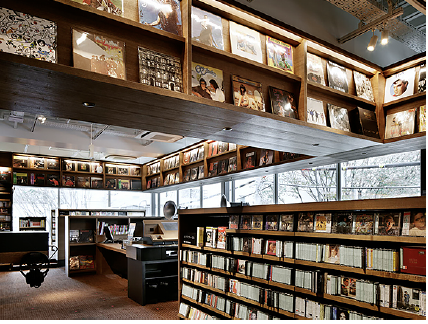 Source: store.tsite.jp
Source: store.tsite.jp[/caption]
Daikanyama Tsutaya T-Site
The Tsutaya T-site is in Daikanyama district. The store has an amazing collection of books which creates a library-like atmosphere. The store spreads across three interlinked buildings with a 55-meter-long aisle that cuts through the store. The interior resembles a traditional library with wooden shelves throughout the store. The selection of goods includes English-language books, art books, a large selection of magazines as well as music and DVDs. The movie section stocks classic titles that may not be easily available on DVD: The store burns the disks at the store for customers to take home. In the Anjin lounge on the second floor, customers can enjoy a wide range of magazines – Japanese and international – while sipping coffee, alcoholic drinks or food from the dining menu. The store also features a travel desk that helps plan trips and itineraries.
Location: Daikanyama Tsutaya T-Site, 17-5 Sarugaku-cho, Shibuya-ku, Tokyo, 150-0033.
[caption id="attachment_91531" align="alignright" width="380"]
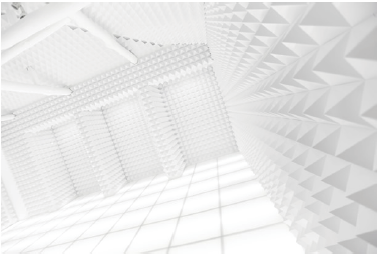
Source: Laila-tokio.com[/caption]
Laila Tokio
Laila Tokio’s interior is covered with 8,000 mini pyramids, creating a sleek and modern look. Laila Tokio does not call itself a concept store: It calls itself a “select shop” as it features select designers such as Helmut Lang and Raf Simons. The shop says it does not follow trends, and instead stocks items that will always be in style. Apart from apparel, the store also sells jewelry, fashion books and magazines. The store sells its own line as well: Refabric and Laila Tokio, both available in the shop. Refabric curates clothes made from repurposed vintage materials. Laila Tokio blends avant-garde fashion with vintage pieces.
Location: Laila Tokio, 2F1 Chome-5-11 Shibuya, Shibuya-ku, Tokyo 150-0002.
[caption id="attachment_91532" align="alignright" width="398"]
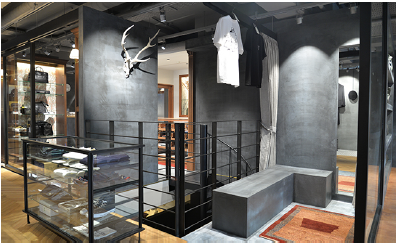 Source: yoshidakaban.com
Source: yoshidakaban.com[/caption]
Porter Omotesando
The luggage at Porter Omotesando can be a unique souvenir – or to use for travel. The Porter Omostesando flagship is a concept store with three key features: a store, a museum and a workshop. The workshop displays the manufacturing process and the gallery provides showcases and events. The store itself is two floors and features other brands.
Location: Porter Omotesando, 5 Chome-6-8 Jingumae, Shibuya City, Tokyo 150-0001.
[caption id="attachment_91533" align="alignright" width="410"]
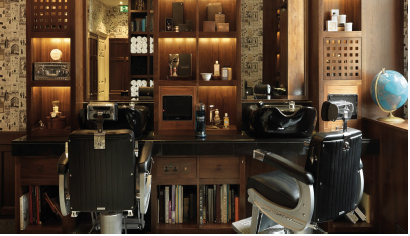 Source: dunhill.com
Source: dunhill.com[/caption]
Dunhill
The Dunhill flagship in Ginza is an experiential store, designed to create a masculine and contemporary look and feel. The purpose is to create a brand experience and bolster its position as a leader of British luxury menswear. On the first and second floors customers can find the Dunhill Bar, run by chef Yoshihisa Akiyama and serving contemporary Japanese food – with just a hint of a British twist. Apart from the bar, there is also a barber service on the first floor, a partnership with Barba Tokyo. The barber shop provides the usual services such as men’s grooming and shaving, however, it also offers spa treatments – creating the ultimate luxury experience. The Ginza Dunhill store offers Dunhill products that aren’t available anywhere else, such as a traditional Japanese kimono that sells for $11,000. The store design features bronzed brass and wood, incorporating black leather and black detail throughout the store, keeping with the brand’s aesthetic.
Location: Dunhill, 2 Chome-6-7 Ginza, Chuo City, Tokyo 104-0061.
[caption id="attachment_91534" align="alignright" width="344"]
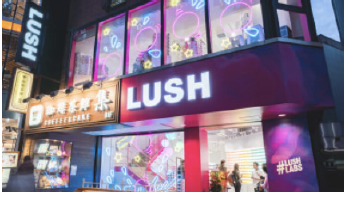 Source: jn.lush.com
Source: jn.lush.com[/caption]
Lush
Lush Harajuku is the first Lush store in the world to offer only bath bombs, no other products – and many of the bath bombs at the store cannot be found elsewhere. Lush also started the NAKED concept: Cosmetics sold without packaging – a real innovation in packaging-crazy Japan. Lush’s motive to create this store was to promote Japan’s unique bathing culture: People are eschewing the ritual of a bath and taking showers. Lush hopes the bath bomb concept store will promote baths – and support its products.
The store in Harajuku also features an app called Lush Labs made specifically for this store. Shoppers can use the “Lush Lens” to scan bath bombs and get information on the app, such as name, description, ingredients, price etc. Lush offers 57 bath bombs that are exclusive to the store.
Location: Lush, 1 Chome-13-11, Jingumae, Shibuya City, Tokyo 150-0001.
[caption id="attachment_91535" align="alignright" width="342"]
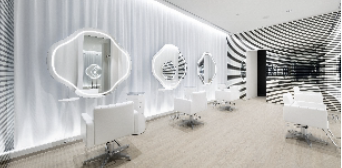 Source: shiseidogroup.com
Source: shiseidogroup.com[/caption]
Shiseido
Shiseido’s flagship store in Ginza transforms shopping into an experience. Each floor has a different purpose, according to Oki Sato, head of design at Nendo & Keita Aaono. The ground floor is Beauty Square 1, products from the company’s Cle de Peau Beaute line are presented with elegant light fixtures all around. The floor also has a styling bar for hair and makeup consolations. The second floor is Beauty Square 2, displaying cosmetics and fragrances, plus a “beauty up” cabin for beauty treatments. The third floor features the Beauty Bar and Photo Studio, offering makeovers and photos of the results. The fourth floor houses Shiseido The Tables, a café, as well as a gallery space featuring art from Mai Miyake and other artists.
Location: Shiseido, 7-8-10 Ginza, Chuo-ku, Tokyo.
[caption id="attachment_91536" align="alignright" width="344"]
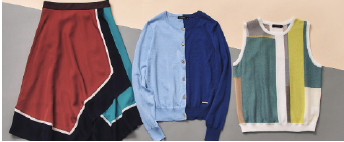 Source: loveless-shop.jp
Source: loveless-shop.jp[/caption]
Loveless
Loveless is a four-story store that is half underground: Two floors underground and two above ground. The brand is operated by Sanyo Shokai, and features avant-garde fashion with a punk flare. The underground section is known as “the dark side,” and entry involves descending staircases reminiscent of entering a dungeon. The first basement floor features a bar and a vast selection of coffee. The interior of the lower floors contains a chandelier and faux brick walls covered in art. The owner of Loveless travels to New York, Milan and Paris to stock the shop, including brands such as Anne Valerie Hash, Paco Rabanne, as well as a selection of vintage pieces from New York. The second floor is called the “Sunny Side” and features a variety of affordable accessories and clothing.
Location: Loveless, 3-7-11 Minami-Aoyama, Minato-ku, Tokyo.
[caption id="attachment_91537" align="alignright" width="406"]
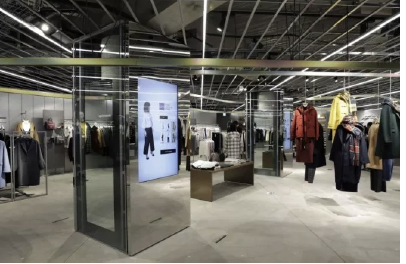 Source: insider-trends.com
Source: insider-trends.com[/caption]
GU Style Studio
The GU Style Studio was opened by Fast Retailing, the parent company of Uniqlo. The store concept combines offline and online: Shoppers can try on merchandise but place an order online for later delivery. The style studio also includes features such as trying different clothing combinations on a virtual mannequin. When customers find pieces they want, they scan a QR code on the clothes to bring up purchase links on their phones.
Location 1 : GU Style Studio, 1 Chome 13-14, Jingumae, Shibuya City, Tokyo 150-0001.
Location 2: GU Style Studio, Harajuku Quest 2F, 1-13-14 Jingumae, Shibuya-ku, Tokyo 150-0001.
[caption id="attachment_91538" align="alignright" width="402"]
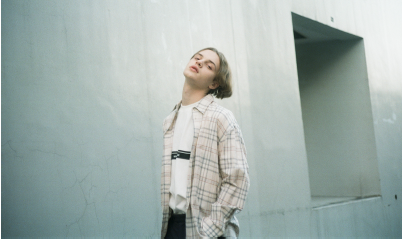 Source: senseofplace.jp
Source: senseofplace.jp[/caption]
Sense of Place by Urban Research
Sense of Place is Urban Research’s first fast-fashion line and has five stores in four different cities: Tokyo, Osaka, Fukuoka and Nagoya. Products are reminiscent of Urban Outfitters and Forever 21 – but with a Tokyo flair. The store is a combination of a coffee and juice bar, flower shop, home goods shop and womenswear store. Products range from luxury vintage designer handbags to makeup.
Location: Sense of Place, 1 2F, 6 Chome-28-6, Jingumae, Shibuya City, Tokyo 150-0001.
[caption id="attachment_91539" align="alignright" width="404"]
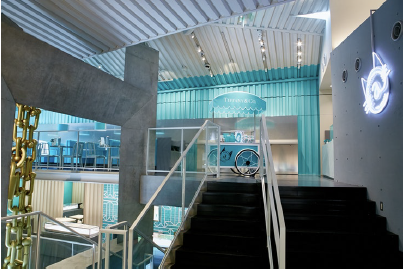 Source: afar.com
Source: afar.com[/caption]
Tiffany & Co
Tiffany & Co’s concept store is located on what is known as Cat Street – known better for outdoor and athletic stores. The Tiffany & Co store is 5,000 square feet spread across six floors and follows the classic colorway of Tiffany blue and white. The first floor has a vending machine that sells perfumes. On the lower level there are customization corners where shoppers can have products engraved on the spot. The lower level also features a Tokyo-themed photo booth. The store has a Tiffany Café on the top floor, Japan’s first, with an American diner atmosphere and food to match: hot dogs, cheese pretzels, and Tiffany blue colored doughnuts.
Location: Tiffany & Co, Jingu-Mae 6-14-5, Shibuya-ku, Tokyo 150-0001.
Must-See Area: Shimo-Kitazawa
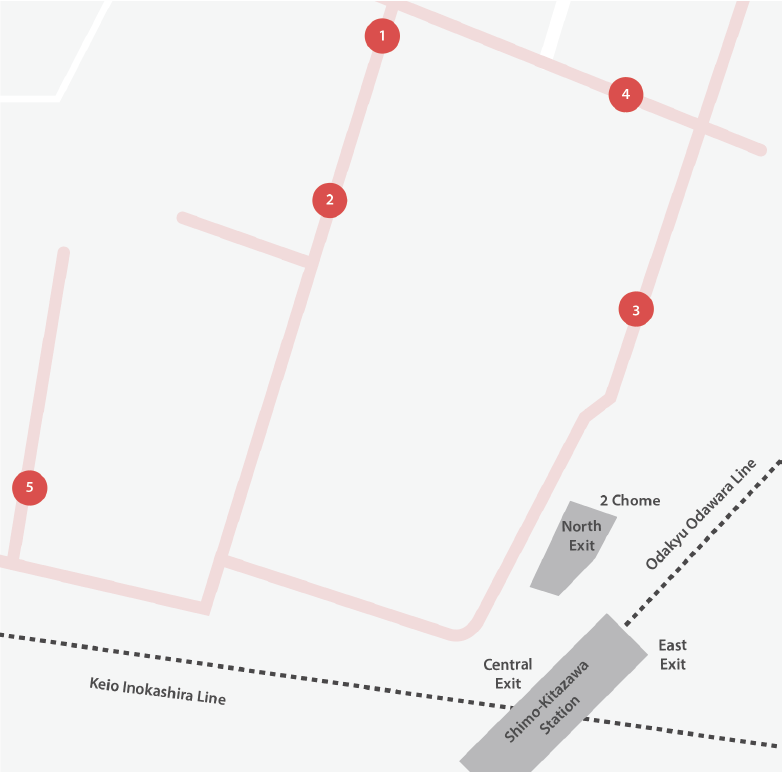
Shimokitazawa is the trendy vintage area of Tokyo, with a plethora of secondhand, vintage stores featuring 70s to 90s clothing, as well as record shops. Shimokitazawa is Tokyo’s Bohemian hub, consumers can also find hipster coffee shops and live music – not found elsewhere in Tokyo.
- Flamingo Shimokitazawa: A thrift store which sells a variety of vintage pieces for men and women.
- Shimokitazawa Garage Department: The store sells vintage goods and offers a chic and grunge style. The store also sells handmade jewelry and features small, up and coming artists.
- KALDI Coffee Farm Shimokitazawa Kitaguchi: This store is a hybrid between an international grocery store and a coffee tasting destination, with a variety of different and new coffees.
- Chaen Oyama: A Japanese tea store with local Japanese herbal products, including a cozy café hidden upstairs in which consumers can enjoy a variety of shaved iced.
- MUJI: A minimalistic Japanese retailer that sells apparel, home goods, stationary and more.
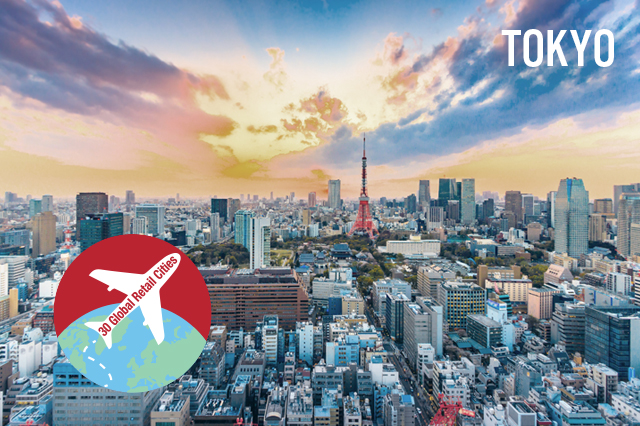
 Source: store.tsite.jp[/caption]
Daikanyama Tsutaya T-Site
The Tsutaya T-site is in Daikanyama district. The store has an amazing collection of books which creates a library-like atmosphere. The store spreads across three interlinked buildings with a 55-meter-long aisle that cuts through the store. The interior resembles a traditional library with wooden shelves throughout the store. The selection of goods includes English-language books, art books, a large selection of magazines as well as music and DVDs. The movie section stocks classic titles that may not be easily available on DVD: The store burns the disks at the store for customers to take home. In the Anjin lounge on the second floor, customers can enjoy a wide range of magazines – Japanese and international – while sipping coffee, alcoholic drinks or food from the dining menu. The store also features a travel desk that helps plan trips and itineraries.
Location: Daikanyama Tsutaya T-Site, 17-5 Sarugaku-cho, Shibuya-ku, Tokyo, 150-0033.
[caption id="attachment_91531" align="alignright" width="380"]
Source: store.tsite.jp[/caption]
Daikanyama Tsutaya T-Site
The Tsutaya T-site is in Daikanyama district. The store has an amazing collection of books which creates a library-like atmosphere. The store spreads across three interlinked buildings with a 55-meter-long aisle that cuts through the store. The interior resembles a traditional library with wooden shelves throughout the store. The selection of goods includes English-language books, art books, a large selection of magazines as well as music and DVDs. The movie section stocks classic titles that may not be easily available on DVD: The store burns the disks at the store for customers to take home. In the Anjin lounge on the second floor, customers can enjoy a wide range of magazines – Japanese and international – while sipping coffee, alcoholic drinks or food from the dining menu. The store also features a travel desk that helps plan trips and itineraries.
Location: Daikanyama Tsutaya T-Site, 17-5 Sarugaku-cho, Shibuya-ku, Tokyo, 150-0033.
[caption id="attachment_91531" align="alignright" width="380"] Source: Laila-tokio.com[/caption]
Laila Tokio
Laila Tokio’s interior is covered with 8,000 mini pyramids, creating a sleek and modern look. Laila Tokio does not call itself a concept store: It calls itself a “select shop” as it features select designers such as Helmut Lang and Raf Simons. The shop says it does not follow trends, and instead stocks items that will always be in style. Apart from apparel, the store also sells jewelry, fashion books and magazines. The store sells its own line as well: Refabric and Laila Tokio, both available in the shop. Refabric curates clothes made from repurposed vintage materials. Laila Tokio blends avant-garde fashion with vintage pieces.
Location: Laila Tokio, 2F1 Chome-5-11 Shibuya, Shibuya-ku, Tokyo 150-0002.
[caption id="attachment_91532" align="alignright" width="398"]
Source: Laila-tokio.com[/caption]
Laila Tokio
Laila Tokio’s interior is covered with 8,000 mini pyramids, creating a sleek and modern look. Laila Tokio does not call itself a concept store: It calls itself a “select shop” as it features select designers such as Helmut Lang and Raf Simons. The shop says it does not follow trends, and instead stocks items that will always be in style. Apart from apparel, the store also sells jewelry, fashion books and magazines. The store sells its own line as well: Refabric and Laila Tokio, both available in the shop. Refabric curates clothes made from repurposed vintage materials. Laila Tokio blends avant-garde fashion with vintage pieces.
Location: Laila Tokio, 2F1 Chome-5-11 Shibuya, Shibuya-ku, Tokyo 150-0002.
[caption id="attachment_91532" align="alignright" width="398"] Source: yoshidakaban.com[/caption]
Porter Omotesando
The luggage at Porter Omotesando can be a unique souvenir – or to use for travel. The Porter Omostesando flagship is a concept store with three key features: a store, a museum and a workshop. The workshop displays the manufacturing process and the gallery provides showcases and events. The store itself is two floors and features other brands.
Location: Porter Omotesando, 5 Chome-6-8 Jingumae, Shibuya City, Tokyo 150-0001.
[caption id="attachment_91533" align="alignright" width="410"]
Source: yoshidakaban.com[/caption]
Porter Omotesando
The luggage at Porter Omotesando can be a unique souvenir – or to use for travel. The Porter Omostesando flagship is a concept store with three key features: a store, a museum and a workshop. The workshop displays the manufacturing process and the gallery provides showcases and events. The store itself is two floors and features other brands.
Location: Porter Omotesando, 5 Chome-6-8 Jingumae, Shibuya City, Tokyo 150-0001.
[caption id="attachment_91533" align="alignright" width="410"] Source: dunhill.com[/caption]
Dunhill
The Dunhill flagship in Ginza is an experiential store, designed to create a masculine and contemporary look and feel. The purpose is to create a brand experience and bolster its position as a leader of British luxury menswear. On the first and second floors customers can find the Dunhill Bar, run by chef Yoshihisa Akiyama and serving contemporary Japanese food – with just a hint of a British twist. Apart from the bar, there is also a barber service on the first floor, a partnership with Barba Tokyo. The barber shop provides the usual services such as men’s grooming and shaving, however, it also offers spa treatments – creating the ultimate luxury experience. The Ginza Dunhill store offers Dunhill products that aren’t available anywhere else, such as a traditional Japanese kimono that sells for $11,000. The store design features bronzed brass and wood, incorporating black leather and black detail throughout the store, keeping with the brand’s aesthetic.
Location: Dunhill, 2 Chome-6-7 Ginza, Chuo City, Tokyo 104-0061.
[caption id="attachment_91534" align="alignright" width="344"]
Source: dunhill.com[/caption]
Dunhill
The Dunhill flagship in Ginza is an experiential store, designed to create a masculine and contemporary look and feel. The purpose is to create a brand experience and bolster its position as a leader of British luxury menswear. On the first and second floors customers can find the Dunhill Bar, run by chef Yoshihisa Akiyama and serving contemporary Japanese food – with just a hint of a British twist. Apart from the bar, there is also a barber service on the first floor, a partnership with Barba Tokyo. The barber shop provides the usual services such as men’s grooming and shaving, however, it also offers spa treatments – creating the ultimate luxury experience. The Ginza Dunhill store offers Dunhill products that aren’t available anywhere else, such as a traditional Japanese kimono that sells for $11,000. The store design features bronzed brass and wood, incorporating black leather and black detail throughout the store, keeping with the brand’s aesthetic.
Location: Dunhill, 2 Chome-6-7 Ginza, Chuo City, Tokyo 104-0061.
[caption id="attachment_91534" align="alignright" width="344"] Source: jn.lush.com[/caption]
Lush
Lush Harajuku is the first Lush store in the world to offer only bath bombs, no other products – and many of the bath bombs at the store cannot be found elsewhere. Lush also started the NAKED concept: Cosmetics sold without packaging – a real innovation in packaging-crazy Japan. Lush’s motive to create this store was to promote Japan’s unique bathing culture: People are eschewing the ritual of a bath and taking showers. Lush hopes the bath bomb concept store will promote baths – and support its products.
The store in Harajuku also features an app called Lush Labs made specifically for this store. Shoppers can use the “Lush Lens” to scan bath bombs and get information on the app, such as name, description, ingredients, price etc. Lush offers 57 bath bombs that are exclusive to the store.
Location: Lush, 1 Chome-13-11, Jingumae, Shibuya City, Tokyo 150-0001.
[caption id="attachment_91535" align="alignright" width="342"]
Source: jn.lush.com[/caption]
Lush
Lush Harajuku is the first Lush store in the world to offer only bath bombs, no other products – and many of the bath bombs at the store cannot be found elsewhere. Lush also started the NAKED concept: Cosmetics sold without packaging – a real innovation in packaging-crazy Japan. Lush’s motive to create this store was to promote Japan’s unique bathing culture: People are eschewing the ritual of a bath and taking showers. Lush hopes the bath bomb concept store will promote baths – and support its products.
The store in Harajuku also features an app called Lush Labs made specifically for this store. Shoppers can use the “Lush Lens” to scan bath bombs and get information on the app, such as name, description, ingredients, price etc. Lush offers 57 bath bombs that are exclusive to the store.
Location: Lush, 1 Chome-13-11, Jingumae, Shibuya City, Tokyo 150-0001.
[caption id="attachment_91535" align="alignright" width="342"] Source: shiseidogroup.com[/caption]
Shiseido
Shiseido’s flagship store in Ginza transforms shopping into an experience. Each floor has a different purpose, according to Oki Sato, head of design at Nendo & Keita Aaono. The ground floor is Beauty Square 1, products from the company’s Cle de Peau Beaute line are presented with elegant light fixtures all around. The floor also has a styling bar for hair and makeup consolations. The second floor is Beauty Square 2, displaying cosmetics and fragrances, plus a “beauty up” cabin for beauty treatments. The third floor features the Beauty Bar and Photo Studio, offering makeovers and photos of the results. The fourth floor houses Shiseido The Tables, a café, as well as a gallery space featuring art from Mai Miyake and other artists.
Location: Shiseido, 7-8-10 Ginza, Chuo-ku, Tokyo.
[caption id="attachment_91536" align="alignright" width="344"]
Source: shiseidogroup.com[/caption]
Shiseido
Shiseido’s flagship store in Ginza transforms shopping into an experience. Each floor has a different purpose, according to Oki Sato, head of design at Nendo & Keita Aaono. The ground floor is Beauty Square 1, products from the company’s Cle de Peau Beaute line are presented with elegant light fixtures all around. The floor also has a styling bar for hair and makeup consolations. The second floor is Beauty Square 2, displaying cosmetics and fragrances, plus a “beauty up” cabin for beauty treatments. The third floor features the Beauty Bar and Photo Studio, offering makeovers and photos of the results. The fourth floor houses Shiseido The Tables, a café, as well as a gallery space featuring art from Mai Miyake and other artists.
Location: Shiseido, 7-8-10 Ginza, Chuo-ku, Tokyo.
[caption id="attachment_91536" align="alignright" width="344"] Source: loveless-shop.jp[/caption]
Loveless
Loveless is a four-story store that is half underground: Two floors underground and two above ground. The brand is operated by Sanyo Shokai, and features avant-garde fashion with a punk flare. The underground section is known as “the dark side,” and entry involves descending staircases reminiscent of entering a dungeon. The first basement floor features a bar and a vast selection of coffee. The interior of the lower floors contains a chandelier and faux brick walls covered in art. The owner of Loveless travels to New York, Milan and Paris to stock the shop, including brands such as Anne Valerie Hash, Paco Rabanne, as well as a selection of vintage pieces from New York. The second floor is called the “Sunny Side” and features a variety of affordable accessories and clothing.
Location: Loveless, 3-7-11 Minami-Aoyama, Minato-ku, Tokyo.
[caption id="attachment_91537" align="alignright" width="406"]
Source: loveless-shop.jp[/caption]
Loveless
Loveless is a four-story store that is half underground: Two floors underground and two above ground. The brand is operated by Sanyo Shokai, and features avant-garde fashion with a punk flare. The underground section is known as “the dark side,” and entry involves descending staircases reminiscent of entering a dungeon. The first basement floor features a bar and a vast selection of coffee. The interior of the lower floors contains a chandelier and faux brick walls covered in art. The owner of Loveless travels to New York, Milan and Paris to stock the shop, including brands such as Anne Valerie Hash, Paco Rabanne, as well as a selection of vintage pieces from New York. The second floor is called the “Sunny Side” and features a variety of affordable accessories and clothing.
Location: Loveless, 3-7-11 Minami-Aoyama, Minato-ku, Tokyo.
[caption id="attachment_91537" align="alignright" width="406"] Source: insider-trends.com[/caption]
GU Style Studio
The GU Style Studio was opened by Fast Retailing, the parent company of Uniqlo. The store concept combines offline and online: Shoppers can try on merchandise but place an order online for later delivery. The style studio also includes features such as trying different clothing combinations on a virtual mannequin. When customers find pieces they want, they scan a QR code on the clothes to bring up purchase links on their phones.
Location 1 : GU Style Studio, 1 Chome 13-14, Jingumae, Shibuya City, Tokyo 150-0001.
Location 2: GU Style Studio, Harajuku Quest 2F, 1-13-14 Jingumae, Shibuya-ku, Tokyo 150-0001.
[caption id="attachment_91538" align="alignright" width="402"]
Source: insider-trends.com[/caption]
GU Style Studio
The GU Style Studio was opened by Fast Retailing, the parent company of Uniqlo. The store concept combines offline and online: Shoppers can try on merchandise but place an order online for later delivery. The style studio also includes features such as trying different clothing combinations on a virtual mannequin. When customers find pieces they want, they scan a QR code on the clothes to bring up purchase links on their phones.
Location 1 : GU Style Studio, 1 Chome 13-14, Jingumae, Shibuya City, Tokyo 150-0001.
Location 2: GU Style Studio, Harajuku Quest 2F, 1-13-14 Jingumae, Shibuya-ku, Tokyo 150-0001.
[caption id="attachment_91538" align="alignright" width="402"] Source: senseofplace.jp[/caption]
Sense of Place by Urban Research
Sense of Place is Urban Research’s first fast-fashion line and has five stores in four different cities: Tokyo, Osaka, Fukuoka and Nagoya. Products are reminiscent of Urban Outfitters and Forever 21 – but with a Tokyo flair. The store is a combination of a coffee and juice bar, flower shop, home goods shop and womenswear store. Products range from luxury vintage designer handbags to makeup.
Location: Sense of Place, 1 2F, 6 Chome-28-6, Jingumae, Shibuya City, Tokyo 150-0001.
[caption id="attachment_91539" align="alignright" width="404"]
Source: senseofplace.jp[/caption]
Sense of Place by Urban Research
Sense of Place is Urban Research’s first fast-fashion line and has five stores in four different cities: Tokyo, Osaka, Fukuoka and Nagoya. Products are reminiscent of Urban Outfitters and Forever 21 – but with a Tokyo flair. The store is a combination of a coffee and juice bar, flower shop, home goods shop and womenswear store. Products range from luxury vintage designer handbags to makeup.
Location: Sense of Place, 1 2F, 6 Chome-28-6, Jingumae, Shibuya City, Tokyo 150-0001.
[caption id="attachment_91539" align="alignright" width="404"] Source: afar.com[/caption]
Tiffany & Co
Tiffany & Co’s concept store is located on what is known as Cat Street – known better for outdoor and athletic stores. The Tiffany & Co store is 5,000 square feet spread across six floors and follows the classic colorway of Tiffany blue and white. The first floor has a vending machine that sells perfumes. On the lower level there are customization corners where shoppers can have products engraved on the spot. The lower level also features a Tokyo-themed photo booth. The store has a Tiffany Café on the top floor, Japan’s first, with an American diner atmosphere and food to match: hot dogs, cheese pretzels, and Tiffany blue colored doughnuts.
Location: Tiffany & Co, Jingu-Mae 6-14-5, Shibuya-ku, Tokyo 150-0001.
Must-See Area: Shimo-Kitazawa
Source: afar.com[/caption]
Tiffany & Co
Tiffany & Co’s concept store is located on what is known as Cat Street – known better for outdoor and athletic stores. The Tiffany & Co store is 5,000 square feet spread across six floors and follows the classic colorway of Tiffany blue and white. The first floor has a vending machine that sells perfumes. On the lower level there are customization corners where shoppers can have products engraved on the spot. The lower level also features a Tokyo-themed photo booth. The store has a Tiffany Café on the top floor, Japan’s first, with an American diner atmosphere and food to match: hot dogs, cheese pretzels, and Tiffany blue colored doughnuts.
Location: Tiffany & Co, Jingu-Mae 6-14-5, Shibuya-ku, Tokyo 150-0001.
Must-See Area: Shimo-Kitazawa
 Shimokitazawa is the trendy vintage area of Tokyo, with a plethora of secondhand, vintage stores featuring 70s to 90s clothing, as well as record shops. Shimokitazawa is Tokyo’s Bohemian hub, consumers can also find hipster coffee shops and live music – not found elsewhere in Tokyo.
Shimokitazawa is the trendy vintage area of Tokyo, with a plethora of secondhand, vintage stores featuring 70s to 90s clothing, as well as record shops. Shimokitazawa is Tokyo’s Bohemian hub, consumers can also find hipster coffee shops and live music – not found elsewhere in Tokyo.